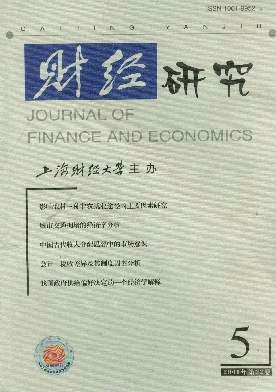中国财政科教支出动态经济效应分析
财经研究 2006 年 第 32 卷第 05 期, 页码:95 - 108
摘要
参考文献
摘要
财政科技与教育支出的经济增长效应是经济学界研究的重要问题。文章通过构建以资本、知识和产出为研究对象的动态理论模型与研究,发现财政科教支出对三者的稳定增长路径及经济体系稳态点均具有重要影响。文章在理论模型研究的基础上进一步构建了动态计量模型,实证结论是:中国财政科教支出对其资本形成、产出增长及全要素生产率的提高均有积极影响,但作用力度和影响方式存在区别。因此,应进一步增加财政科教支出,并通过改进支出结构和进度,使之对经济转轨和长期经济增长起到更为重要的促进作用。
[1]戴维.罗默.高级宏观经济学[M].北京:商务印书馆,2003.
[2]R.G.D.艾伦.数理经济学[M].北京:商务印书馆,2005.
[3]郭庆旺,贾俊雪.中国全要素生产率的估算:1979~2004[J].经济研究,2005,(6):51~60.
[4]郭庆旺.积极财政政策及其与货币政策配合研究[M].北京:中国人民大学出版社,2004.
[5]郭庆旺,赵志耘.财政理论与政策[M].北京:经济科学出版社,2003.
[6]易单辉.数据分析与EVIWS应用[M].北京:中国统计出版社,2005.
[7]马拴友.财政政策与经济增长[D].北京:经济科学出版社,2003:117~138.
[8]马拴友.公共教育支出与经济增长[J].社会科学家,2002,(3):16~21.
[9]张军,施少华.中国经济全要素生产率变动:1952~1998[J].世界经济文汇,2003,(2):17~24.
[10]张军,章元.对资本存量K的再估计[J].经济研究,2003,(7):35~43.
[11]李治堂.人力资本积累、研究开发与内生经济增长[J].北京印刷学院学报,2005,(5):70~73.
[12]Aghion,Philippe,and Howitt Peter.A model of grow through creative destruction[J].Econometrica,1992,60(March):323~351.
[13]Charles Jones.R&D based models of economic growth[J].The Journal of Political E-conomy,1995,103(4):759~784.
[14]Clarida R H.International capital mobility,public investment and economic growth[R].NBER Working Paper,National Bureau of Economic Research,1993.
[15]Dere H C,Chen and Hiau Looi Kee.A model on knowledge and endogenous growth[R].World Bank Policy Research Working Paper,2003,3935.
[16]Grossman,Gene M,Helpman.Endogenous product cycles[J].Economic Journal,101(September):1214~1229.
[17]Grossman,Gene and Elhanan Helpman.Innovation and growth in the global economy[M].MIT Press,1991.
[18]Hall Robert E,Charles I Jones.Why do some countries produce so much more output perworker than others?[J].Quarterly Journal of Economics,1999,114(2):83~116.
[19]Howitt,Peter and Philippe Aghion.Capital accumulation and innovation as complementaryfactors in long-fun growth[J].Journal of Economic Growth,1998,3(6):111~130.
[20]Jones Charles.R&D based models of economic growth[J].Journal of Political Econo-my,1995,103:759~784.
[21]Jones Charles.Growth:With or without scale effects?[J].American Economic Re-view,1999,89(2):139~144.
[22]Jorgenson Dale W,Kevin Stiroh.Raising the speed limit:U.S.economic growth inthe information age[J].Brookings Papers on Economic Activity,2000,1:125~211.
[23]Kortum Samuel.Research,patenting and technological change[J].Econometrica,1997,65(6):1389~1419.
[24]Krueger,Allan B,Mikael Lindahl.Education for growth:Why and for whom?[R].National Bureau of Economic Research Working Paper,2000,No.7591.
[25]McMillin Smyth.A multivariate time series analysis of the United State aggregate pro-duction function[J].Empirical Economics,1994,(3):659~673.
[26]Park Watler G.A theoretical model of government research and growth[J].Journal ofEconomic Behavior and Organization,1998,34:69~85.
[27]Paul M Romer.Increasing returns and long run growth[J].The Journal of Political E-conomy,1986,94(5):1002~1037.
[28]Romer Paul M.Endogenous technological change[J].Journal of Political Economy,1990,98(October,Part 2):71~102.
[29]Robert E Locus.On the mechanics of economic development[J].Journal of MonetaryEconomics,1998,22(3):30~42.
①以全要素生产率代替知识和人力资本存量,相当于将产出方程(1)中的H和A统一用全要素生产率代表,变为形如Y=TFP[(1-αk)Kα(1-αL)L1-α]的简化方程,这样可以通过分析财政科技与教育支出对全要素生产率的影响,得出两者分别对知识和人力资本存量产生的整体影响。
②参见《中华人民共和国教育法》第五十五条。
[2]R.G.D.艾伦.数理经济学[M].北京:商务印书馆,2005.
[3]郭庆旺,贾俊雪.中国全要素生产率的估算:1979~2004[J].经济研究,2005,(6):51~60.
[4]郭庆旺.积极财政政策及其与货币政策配合研究[M].北京:中国人民大学出版社,2004.
[5]郭庆旺,赵志耘.财政理论与政策[M].北京:经济科学出版社,2003.
[6]易单辉.数据分析与EVIWS应用[M].北京:中国统计出版社,2005.
[7]马拴友.财政政策与经济增长[D].北京:经济科学出版社,2003:117~138.
[8]马拴友.公共教育支出与经济增长[J].社会科学家,2002,(3):16~21.
[9]张军,施少华.中国经济全要素生产率变动:1952~1998[J].世界经济文汇,2003,(2):17~24.
[10]张军,章元.对资本存量K的再估计[J].经济研究,2003,(7):35~43.
[11]李治堂.人力资本积累、研究开发与内生经济增长[J].北京印刷学院学报,2005,(5):70~73.
[12]Aghion,Philippe,and Howitt Peter.A model of grow through creative destruction[J].Econometrica,1992,60(March):323~351.
[13]Charles Jones.R&D based models of economic growth[J].The Journal of Political E-conomy,1995,103(4):759~784.
[14]Clarida R H.International capital mobility,public investment and economic growth[R].NBER Working Paper,National Bureau of Economic Research,1993.
[15]Dere H C,Chen and Hiau Looi Kee.A model on knowledge and endogenous growth[R].World Bank Policy Research Working Paper,2003,3935.
[16]Grossman,Gene M,Helpman.Endogenous product cycles[J].Economic Journal,101(September):1214~1229.
[17]Grossman,Gene and Elhanan Helpman.Innovation and growth in the global economy[M].MIT Press,1991.
[18]Hall Robert E,Charles I Jones.Why do some countries produce so much more output perworker than others?[J].Quarterly Journal of Economics,1999,114(2):83~116.
[19]Howitt,Peter and Philippe Aghion.Capital accumulation and innovation as complementaryfactors in long-fun growth[J].Journal of Economic Growth,1998,3(6):111~130.
[20]Jones Charles.R&D based models of economic growth[J].Journal of Political Econo-my,1995,103:759~784.
[21]Jones Charles.Growth:With or without scale effects?[J].American Economic Re-view,1999,89(2):139~144.
[22]Jorgenson Dale W,Kevin Stiroh.Raising the speed limit:U.S.economic growth inthe information age[J].Brookings Papers on Economic Activity,2000,1:125~211.
[23]Kortum Samuel.Research,patenting and technological change[J].Econometrica,1997,65(6):1389~1419.
[24]Krueger,Allan B,Mikael Lindahl.Education for growth:Why and for whom?[R].National Bureau of Economic Research Working Paper,2000,No.7591.
[25]McMillin Smyth.A multivariate time series analysis of the United State aggregate pro-duction function[J].Empirical Economics,1994,(3):659~673.
[26]Park Watler G.A theoretical model of government research and growth[J].Journal ofEconomic Behavior and Organization,1998,34:69~85.
[27]Paul M Romer.Increasing returns and long run growth[J].The Journal of Political E-conomy,1986,94(5):1002~1037.
[28]Romer Paul M.Endogenous technological change[J].Journal of Political Economy,1990,98(October,Part 2):71~102.
[29]Robert E Locus.On the mechanics of economic development[J].Journal of MonetaryEconomics,1998,22(3):30~42.
①以全要素生产率代替知识和人力资本存量,相当于将产出方程(1)中的H和A统一用全要素生产率代表,变为形如Y=TFP[(1-αk)Kα(1-αL)L1-α]的简化方程,这样可以通过分析财政科技与教育支出对全要素生产率的影响,得出两者分别对知识和人力资本存量产生的整体影响。
②参见《中华人民共和国教育法》第五十五条。
引用本文
郭玉清, 刘红, 郭庆旺. 中国财政科教支出动态经济效应分析[J]. 财经研究, 2006, 32(5): 95–108.
导出参考文献,格式为:





 6808
6808  8427
8427

